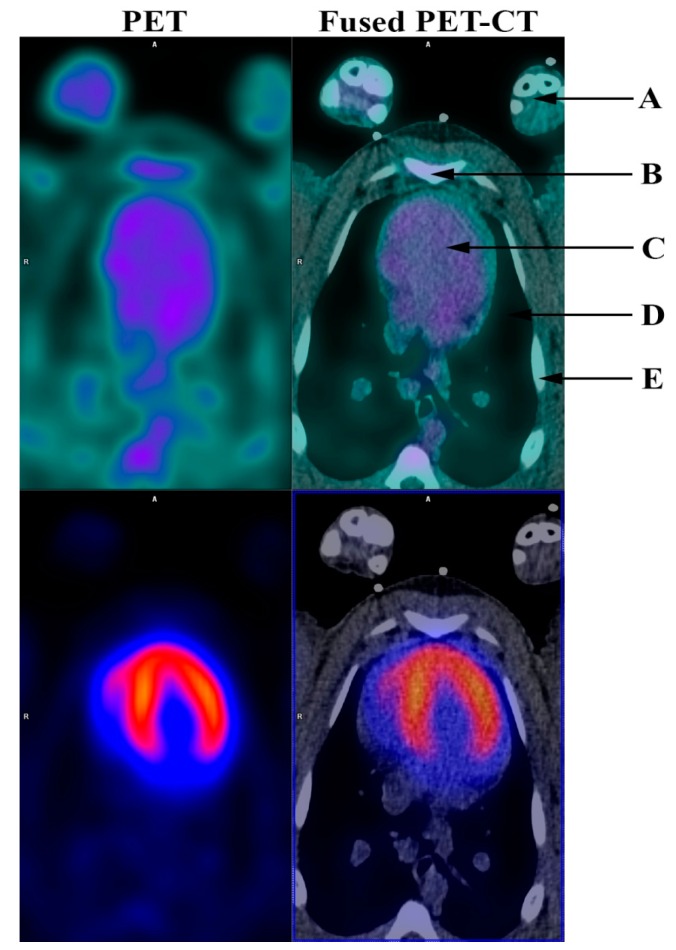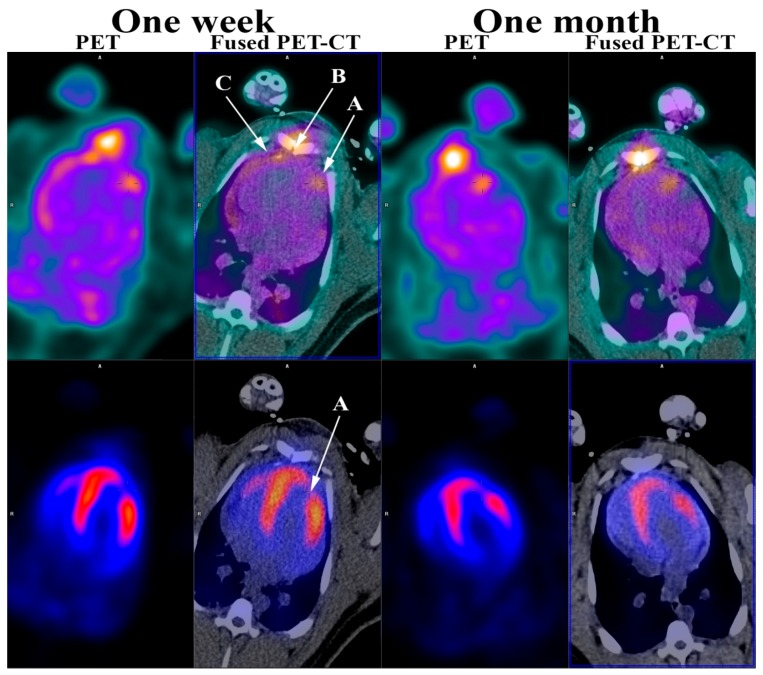Abstract
Angiogenesis is part of the healing process following an ischemic injury and is vital for the post-ischemic repair of the myocardium. Therefore, it is of particular interest to be able to noninvasively monitor angiogenesis. This might, not only permit risk stratification of patients following myocardial infarction, but could also facilitate development and improvement of new therapies directed towards stimulation of the angiogenic response. During angiogenesis endothelial cells must adhere to one another to form new microvessels. αvβ3 integrin has been found to be highly expressed in activated endothelial cells and has been identified as a critical modulator of angiogenesis. 68Ga-NODAGA-E[c(RGDyK)]2 (RGD) has recently been developed by us as an angiogenesis positron-emission-tomography (PET) ligand targeted towards αvβ3 integrin. In the present study, we induced myocardial infarction in Göttingen minipigs. Successful infarction was documented by 82Rubidium-dipyridamole stress PET and computed tomography. RGD uptake was demonstrated in the infarcted myocardium one week and one month after induction of infarction by RGD-PET. In conclusion, we demonstrated angiogenesis by noninvasive imaging using RGD-PET in minipigs hearts, which resemble human hearts. The perspectives are very intriguing and might permit the evaluation of new treatment strategies targeted towards increasing the angiogenetic response, e.g., stem-cell treatment.
Keywords: positron-emission-tomography, angiogenesis, myocardial infarction
Figure 1.
Angiogenesis PET (RGD PET) (top row) and 82Rb dipyridamole stress PET (bottom row) before induced myocardial infarction. (A) Front limbs; (B) Sternum; (C) Heart; (D) Lungs; (E) Ribs. Angiogenesis is part of the healing process following an ischemic injury and is vital for the post-ischemic repair of the myocardium. It is associated with the remodeling of the left ventricle and thus prognosis following myocardial infarction [1]. Therefore, it is of particular interest to be able to noninvasively monitor angiogenesis. This might not only permit risk stratification of patients following myocardial infarction, but could also facilitate development and improvement of new therapies directed towards stimulation of the angiogenic response. During angiogenesis endothelial cells must adhere to one another to form new microvessels. This is a process modulated by the extracellular matrix including integrins. Specifically, αvβ3 integrin is highly expressed in activated endothelial cells and has been identified as a critical modulator of angiogenesis and is therefore a potential target for directly imaging angiogenesis [2,3]. Existing noninvasive imaging methods directed towards the evaluation of angiogenesis have however been somewhat limited, possibly due to the fact that myocardial angiogenesis following myocardial infarction might be focal and therefore difficult to detect. Furthermore, most of the previous studies in angiogenesis imaging have been performed in smaller animals, mostly rats [4,5,6,7,8,9,10,11,12,13]. 68Ga-NODAGA-E[c(RGDyK)]2 (RGD) has recently been developed by us as an angiogenesis positron-emission-tomography (PET) ligand targeted towards αvβ3 integrin [14]. In the present study, we induced myocardial infarction in Göttingen minipigs [15]. Successful infarction was documented by 82Rubidium (82Rb)-dipyridamole stress PET and computed tomography (CT) (Siemens mCT, Siemens, 128-slice CT, Knoxville, USA). RGD uptake was demonstrated in the infarcted myocardium one week and one month after induction of infarction by RGD-PET. The study was approved by the National Authority in Denmark (approval number: 2014-15-0201-00191). During the PET acquisition minipigs were anesthetized as described in detail previously [15]. Baseline 82Rb rest and stress myocardial perfusion were performed the week prior to induction of myocardial infarction as a 7 min dynamic PET myocardial perfusion rest scan under administration of 1000–1200 MBq 82Rb followed by a 7 min dynamic dipyridamole stress PET-CT. Dipyridamole (140 µg/kg/min) was given as a continuous intravenous infusion over 4 min prior to 82Rb-tracer injection 3–5 min after the completion of dipyridamole infusion. The RGD-PET was performed as a 10 min ECG-gated scan 45 min after administration of 100 MBq RGD. PET images were analyzed using Cedars-Sinai Cardiac Suite (Cedars-Sinai Medical Center, Los Angeles, CA, USA) for Syngo. Via (Siemens, Knoxville, TN, USA). The figure shows RGD and 82Rb stress PET images before induction of myocardial infarction. 82Rb stress PET showed even distribution of 82Rb in the left ventricle while the RGD PET showed no RGD uptake.
Figure 2.
RGD (top row) and 82Rb stress PET (bottom row) one week and one month after induced myocardial infarction. (A) Myocardial infarction; (B) Sternotomy; (C) Pericardium. As shown, the 82Rb stress PET (bottom row) showed a myocardial perfusion defect in the anterior wall of the left ventricle myocardium one week and one month after induced myocardial infarction confirming a myocardial infarction corresponding to an area supplied by the ligated branch from LAD. This myocardial perfusion defect was also present at rest (not shown). Furthermore, the RGD PET (top row) showed RGD uptake in the infarcted myocardium one week and one month following myocardial infarction. In addition, RGD PET showed RGD uptake in the sternum after sternotomy and pericardium, most likely due to the opening as part of the infarct induction procedure. As previously mentioned, most of the previous work in angiogenesis imaging have been done in smaller animals. The minipig heart and the human heart are very much alike, which makes the findings in this study even more encouraging and adds to the few, mostly very small, studies performed in human [16,17,18]. The perspectives are very intriguing and might permit the evaluation of new treatment strategies targeted towards increasing the angiogenetic response, e.g., stem-cell treatment.
Acknowledgments
Great thanks to Christian Joost Holdflod Moeller for his help with the induction of the myocardial infarction.
Conflicts of Interest
The authors declare no conflicts of interest.
References
- 1.Ja K.M.M., Miao Q., Zhen Tee N.G., Lim S.Y., Nandihalli M., Ramachandra C.J.A., Mehta A., Shim W. iPSC-derived human cardiac progenitor cells improve ventricular remodelling via angiogenesis and interstitial networking of infarcted myocardium. J. Cell. Mol. Med. 2016;20:323–332. doi: 10.1111/jcmm.12725. [DOI] [PMC free article] [PubMed] [Google Scholar]
- 2.Chen H., Niu G., Wu H., Chen X. Clinical Application of Radiolabeled RGD Peptides for PET Imaging of Integrin alphavbeta3. Theranostics. 2016;6:78–92. doi: 10.7150/thno.13242. [DOI] [PMC free article] [PubMed] [Google Scholar]
- 3.Dobrucki L.W., Sinusas A.J. Imaging angiogenesis. Curr. Opin. Biotechnol. 2007;18:90–96. doi: 10.1016/j.copbio.2007.01.005. [DOI] [PubMed] [Google Scholar]
- 4.Cai M., Ren L., Yin X., Guo Z., Li Y., He T., Tang Y., Long T., Liu Y., Liu G., et al. PET monitoring angiogenesis of infarcted myocardium after treatment with vascular endothelial growth factor and bone marrow mesenchymal stem cells. Amino Acids. 2016;48:811–820. doi: 10.1007/s00726-015-2129-4. [DOI] [PubMed] [Google Scholar]
- 5.Kiugel M., Dijkgraaf I., Kyto V., Helin S., Liljenback H., Saanijoki T., Yim C., Oikonen V., Saukko P., Knuuti J., et al. Dimeric [68Ga]DOTA-RGD peptide targeting alphavbeta 3 integrin reveals extracellular matrix alterations after myocardial infarction. Mol. Imaging Biol. 2014;16:793–801. doi: 10.1007/s11307-014-0752-1. [DOI] [PubMed] [Google Scholar]
- 6.Eo J.S., Paeng J.C., Lee S., Lee Y.S., Jeong J.M., Kang K.W., Chung J.K., Lee D.S. Angiogenesis imaging in myocardial infarction using 68Ga-NOTA-RGD PET: characterization and application to therapeutic efficacy monitoring in rats. Coron. Artery Dis. 2013;24:303–311. doi: 10.1097/MCA.0b013e3283608c32. [DOI] [PubMed] [Google Scholar]
- 7.Laitinen I., Notni J., Pohle K., Rudelius M., Farrell E., Nekolla S.G., Henriksen G., Neubauer S., Kessler H., Wester H.-J., et al. Comparison of cyclic RGD peptides for αvβ3 integrin detection in a rat model of myocardial infarction. EJNMMI Res. 2013;3 doi: 10.1186/2191-219X-3-38. [DOI] [PMC free article] [PubMed] [Google Scholar]
- 8.Menichetti L., Kusmic C., Panetta D., Arosio D., Petroni D., Matteucci M., Salvadori P.A., Casagrande C., L'Abbate A., Manzoni L. MicroPET/CT imaging of αvβ3 integrin via a novel 68Ga-NOTA-RGD peptidomimetic conjugate in rat myocardial infarction. Eur. J. Nucl. Med. Mol. Imaging. 2013;40:1265–1274. doi: 10.1007/s00259-013-2432-9. [DOI] [PubMed] [Google Scholar]
- 9.Gao H., Lang L., Guo N., Cao F., Quan Q., Hu S., Kiesewetter D.O., Niu G., Chen X. PET imaging of angiogenesis after myocardial infarction/reperfusion using a one-step labeled integrin-targeted tracer 18F-AlF-NOTA-PRGD2. Eur. J. Nucl. Med. Mol. Imaging. 2012;39:683–692. doi: 10.1007/s00259-011-2052-1. [DOI] [PMC free article] [PubMed] [Google Scholar]
- 10.Sherif H.M., Saraste A., Nekolla S.G., Weidl E., Reder S., Tapfer A., Rudelius M., Higuchi T., Botnar R.M., Wester H.J., et al. Molecular imaging of early αvβ3 integrin expression predicts long-term left-ventricle remodeling after myocardial infarction in rats. J. Nucl. Med. 2012;53:318–323. doi: 10.2967/jnumed.111.091652. [DOI] [PubMed] [Google Scholar]
- 11.Laitinen I., Saraste A., Weidl E., Poethko T., Weber A.W., Nekolla S.G., Leppänen P., Ylä-Herttuala S., Hölzlwimmer G., Walch A., et al. Evaluation of αvβ3 integrin-targeted positron emission tomography tracer 18F-galacto-RGD for imaging of vascular inflammation in atherosclerotic mice. Circ. Cardiovasc. Imaging. 2009;2:331–338. doi: 10.1161/CIRCIMAGING.108.846865. [DOI] [PubMed] [Google Scholar]
- 12.Higuchi T., Bengel F.M., Seidl S., Watzlowik P., Kessler H., Hegenloh R., Reder S., Nekolla S.G., Wester H.J., Schwaiger M. Assessment of αvβ3 integrin expression after myocardial infarction by positron emission tomography. Cardiovasc. Res. 2008;78:395–403. doi: 10.1093/cvr/cvn033. [DOI] [PubMed] [Google Scholar]
- 13.Meoli D.F., Sadeghi M.M., Krassilnikova S., Bourke B.N., Giordano F.J., Dione D.P., Su H., Edwards D.S., Liu S., Harris T.D., et al. Noninvasive imaging of myocardial angiogenesis following experimental myocardial infarction. J. Clin. Investig. 2004;113:1684–1691. doi: 10.1172/JCI200420352. [DOI] [PMC free article] [PubMed] [Google Scholar]
- 14.Oxboel J., Brandt-Larsen M., Schjoeth-Eskesen C., Myschetzky R., El-Ali H.H., Madsen J., Kjaer A. Comparison of two new angiogenesis PET tracers 68Ga-NODAGA-E[c(RGDyK)]2 and 64Cu-NODAGA-E[c(RGDyK)]2; in vivo imaging studies in human xenograft tumors. Nucl. Med. Biol. 2014;41:259–267. doi: 10.1016/j.nucmedbio.2013.12.003. [DOI] [PubMed] [Google Scholar]
- 15.Rasmussen T., Follin B., Kastrup J., Christensen T.E., Hammelev K.P., Kjaer A., Hasbak P. Myocardial perfusion of infarcted and normal myocardium in propofol-anesthetized minipigs using Rubidium PET. J. Nucl. Cardiol. 2016;23:599–603. doi: 10.1007/s12350-016-0453-z. [DOI] [PubMed] [Google Scholar]
- 16.Makowski M.R., Ebersberger U., Nekolla S., Schwaiger M. In vivo molecular imaging of angiogenesis, targeting αvβ3 integrin expression, in a patient after acute myocardial infarction. Eur. Heart J. 2008;29 doi: 10.1093/eurheartj/ehn129. [DOI] [PubMed] [Google Scholar]
- 17.Luo Y., Sun Y., Zhu Z., Li F. Is the change of integrin αvβ3 expression in the infarcted myocardium related to the clinical outcome? Clin. Nucl. Med. 2014;39:655–657. doi: 10.1097/RLU.0000000000000426. [DOI] [PubMed] [Google Scholar]
- 18.Sun Y., Zeng Y., Zhu Y., Feng F., Xu W., Wu C., Xing B., Zhang W., Wu P., Cui L., et al. Application of 68Ga-PRGD2 PET/CT for αvβ3-integrin imaging of myocardial infarction and stroke. Theranostics. 2014;4:778–786. doi: 10.7150/thno.8809. [DOI] [PMC free article] [PubMed] [Google Scholar]




